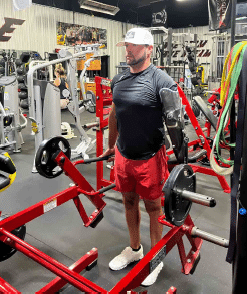If you approach it like it’s a step stool, you’ll start climbing
By Sherri Edge, Arm Dynamics
Photography by Kelby Pechacek
 It seems like nothing can stop Justin Pechacek from achieving his goals. He grew up active in sports, was the captain of his high school football team, graduated from college and, two days later, started working at his dad’s oilfield tool business. By adapting to change and overcoming challenges, Justin expanded the company to multiple locations and a team of 100 employees. A few years later, he bought the business. “I’m just wired different. I’ve always been driven, hardheaded and confident.”
It seems like nothing can stop Justin Pechacek from achieving his goals. He grew up active in sports, was the captain of his high school football team, graduated from college and, two days later, started working at his dad’s oilfield tool business. By adapting to change and overcoming challenges, Justin expanded the company to multiple locations and a team of 100 employees. A few years later, he bought the business. “I’m just wired different. I’ve always been driven, hardheaded and confident.”
When he’s not on the job with his team, Justin is managing livestock, crops and machinery on the west Texas ranch where he lives with his wife, Kelby, and their three children. Justin has a lot of interests, but right now being a pilot tops the list. “I’m a little obsessed with flying my helicopter. Of all the things I do, that is my deal! And it’s because I worked so hard to be able to do it.”
There’s just one problem. It takes two hands to pilot a helicopter, and on June 29, 2022, he lost his left hand and forearm in an accident on the ranch. Justin and Kelby were outside when he walked down to the well house to start another well for the irrigation pivot. “I turned it on and there was a hissing sound, so I leaned over to take a look, resting my arm on the tank, and within five seconds it blew up.” The tank shot up through the metal roof of the building and landed 200 yards out in the field. “It knocked me on my back. I looked over at my arm and thought, ‘Man, this ain’t good.’”
Kelby called 911, jumped in her car and got Justin to the ER in seven minutes. He was Medi flighted from the local hospital to a trauma center in Lubbock, where surgeons attempted to save his arm. “It was infected from all the stuff that was in that water well. It could have killed me. So I made it my decision to tell the doctor to amputate, and I haven’t regretted that decision.”

Justin Pechacek at the JP ranch in Texas.
After his amputation, Justin had 11 more surgeries before returning home and learning to navigate life with one hand. “My awesome wife and awesome children helped me with everything from the get-go.” His community rallied around him too and even had a parade in his honor. “My friend said, ‘If it had to happen, I’m glad it happened to Justin because he’ll OVERCOME it.’ People who know me understood that I’d figure it out. I was fullfledged back to work in two months.
 “Our company has a gym for our employees, and my wife and I work out there every morning. So, when I first talked with my prosthetist at Arm Dynamics, he suggested starting with an activity-specific device. But I was also worried about being able to fly my helicopter.” Justin asked his prosthetist about adapting the device so it could clamp onto the helicopter’s controls. “It worked like a champ at the gym, and it works for gripping the helicopter controls too.” He also wears it to do chores on the ranch.
“Our company has a gym for our employees, and my wife and I work out there every morning. So, when I first talked with my prosthetist at Arm Dynamics, he suggested starting with an activity-specific device. But I was also worried about being able to fly my helicopter.” Justin asked his prosthetist about adapting the device so it could clamp onto the helicopter’s controls. “It worked like a champ at the gym, and it works for gripping the helicopter controls too.” He also wears it to do chores on the ranch.
In 2023, Justin was fit with a passive hand that matches his right hand and a myoelectric prosthesis with a TASKA hand. Before trying to fly with a prosthesis, Justin called his best friend, who happens to be his neighbor and a helicopter pilot. “I said, ‘Hey, if you have time this week, I want to see if this thing can work with the helicopter.’ He said, I’ll meet you there in a couple minutes!’” Justin said he was scared at first and a little bit overwhelmed. “But afterward, when I was by myself, I was super emotional. I think it was just knowing that I could go back to normal. Before, I wasn’t sure, but once I did it I was like, ‘Oh, OK–I got it.’ After that day, I haven’t looked back.”
 Justin came to understand that a big part of overcoming upper limb loss is having a positive attitude and being willing to adapt. “Probably the No. 1 challenge was learning to deal with all the little things and not getting mad and feeling sorry for myself.”
Justin came to understand that a big part of overcoming upper limb loss is having a positive attitude and being willing to adapt. “Probably the No. 1 challenge was learning to deal with all the little things and not getting mad and feeling sorry for myself.”
Whether he was figuring out how to button his pants, ride a horse or fly a helicopter, it all came down to believing he could overcome any obstacle in front of him. “This week I was out working cattle. Before I got hurt, I used to rope and drag the cattle, but now I have a hydraulic chute. I adapted.”
“My advice is that, if you approach something thinking ‘I can’t do it,’ then you’re probably not going to be able to. But, if you approach it like it’s a step stool, you’ll start climbing.”

